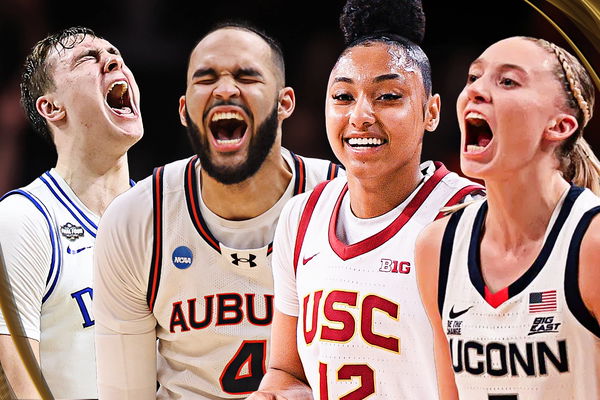
via Imago
Image Credits: IMAGO

via Imago
Image Credits: IMAGO
March Madness is a tapestry of hope and chaos intertwined. Cinderella stories, buzzer-beaters, and legacies forged in adversity make the March Madness Tournament so unique and special. However, for the NCAA, it’s not just about the legacy- money plays a huge role in how things play out!
On paper, March Madness is a billion-dollar machine—but the revenue split is far from equal. The men’s tournament heavily outweighs the women’s in terms of funding and profits, and the NCAA is trying to address that by finally giving the women’s tournament a piece of the pie through their very own units system! At the same time, to promote equity and opportunity for the women’s game, there have been discussions of a joint Final Four weekend.
The question that we’re faced with, however, is whether these measures will usher progress towards actual equity or if we will be left with surface-level parity like before. It’s not like the women’s game is lagging behind the men’s game in terms of viewership over the last few years. After Caitlin Clark’s historic collegiate career, more and more eyeballs have been tracked on the NCAA women’s basketball tournament, but the money side of things is still lacking! How is the NCAA combating this situation? Let’s find out!
ADVERTISEMENT
Article continues below this ad
The Unit System: What Changed in 2025?
Okay, so we know that the NCAA loves to reinvest its profits into the league, but the way they do it is quite complicated. As we know, the basketball athletic association is a billion-dollar machine, and it reinvests about 20% of its earnings through the “Basketball Performance Fund”.
The NCAA makes $1 billion from March Madness.
And distributes 20% of it through the "Basketball Performance Fund".
How it works is fascinating (and worth knowing): 👇 pic.twitter.com/5hWkMYuUwh
— Andrew Petcash (@AndrewPetcash) April 8, 2025
Basically, teams get certain “units” for participating, and advancing in the NCAA Tournament. Each unit in the men’s fund is worth about $340,000, and about $171 million is paid out in total over the span of six years. Not to mention, the total fund grows by 3% yearly. Until now, it was only the men’s game getting dividends from the NCAA, but as of 2025, the women’s game has taken a huge step forward in revenue sharing as well!
For the women, there’s a similar unit system set in place. However, each unit’s value and the total payout are significantly lesser, standing at $113,000 and $15M, respectively! Luckily, it’s bound to grow. Programs currently receive about 26% of the women’s media revenue deal, and there are plans to take it to 41% in the next three years. That would bring up the performance fund to about $25M, and it will grow at the same rate as the men’s fund (2.9% yearly). So even though it’s a step in the right direction for the women’s game, it’s a relatively small step. Especially considering the actual amounts that they’re dealing in!
What’s your perspective on:
Will a joint Final Four weekend truly boost women's basketball, or is it just a gimmick?
Have an interesting take?
The Bigger Picture: Media Rights and Visibility
Frankly, the NCAA is earning billions of dollars through its post-season tournaments, and the media deals are a large part of it! Men’s basketball, for example, has an $8.8B deal over the next eight years, and it plays a huge role in the visibility and publicity of the event.
In contrast, the women’s basketball tournament does not have its own unique media rights deal. Rather, it’s part of a $920 million, eight-year deal that the NCAA has with ESPN for about 40 championships in total. The women’s basketball tournament makes up about 57% of the deal’s value, translating to about $65 million annually.
This disparity affects just about everything. Even though the women’s game is on a meteoric rise, less capital to work with means less endorsements, sponsorships, and investments for the programs. They simply can’t operate at the same level as the men’s game! These concerns are what caused the concept of a ‘joint Final Four’ to arise recently. It would help with visibility, and it would help with profit-sharing. But what exactly does the concept entail?
The Joint Final Four Debate
Women’s basketball and its decision makers have already been catching a lot of flak over the past few years for the super-regional bid that they have. What they did was cut down the traditional four-region setup to just two, removing accessibility for fans and supporters alike! Not only that, but they have forced teams to travel thousands of miles over a short span of time just to play the game. Coaches like Geno Auriemma and Kim Mulkey have been vocal protestors of this system. “You know why they have two regionals? So they can cut cost.” The UConn head coach said, adding that the NCAA is trying to show profits by shortchanging the college athletes.

via Imago
Connecticut Huskies Head Coach Geno Auriemma watches practice at Amalie Arena in Tampa, Florida, Thursday, April 3, 2025 ahead of their Final Four match-up against the UCLA Bruins on Friday.
However, the Joint Final Four proposal isn’t anything like the super-regional bid for the women’s game. This proposal actually intends to hold the men’s and women’s basketball tournament semifinals and title games in the same city on the same weekend. The scheduling would be slightly staggered as it currently is, but the idea is quite revolutionary, to say the least!
Big East commissioner Val Ackerman is a firm supporter of this proposal. “You will get people to say that it shouldn’t happen.” He said, addressing how this idea goes against the grain. “That the women’s tournament is doing just fine. And that’s not without merit. I’m saying if the NCAA is looking for growth, and it is, and is looking for revenue growth–and it is. I can’t think of many ways you could accomplish that in a significant way versus in an incremental way than combining the two Final Fours.”
ADVERTISEMENT
Article continues below this ad
However, there’s no way that this could happen before 2032, with the venues being locked on both sides for the next six years. The logistics alone would be a nightmare for such an idea, not to mention the possible blowback! However, tough decisions will need to be made if the game is supposed to grow.
Why This Moment Matters
The tides have begun shifting in favor of the women’s game, and we’re currently at a defining moment in NCAA history. In the 2024 March Madness championship games, the women’s final averaged 18.9 million viewers on ABC, while the men’s game dropped to around 14.82 million. There’s no doubt that the women’s game is catching up in popularity, and the NCAA needs to be prepared to handle the development and onslaught of this change in fortunes.
ADVERTISEMENT
Article continues below this ad
We’re getting new and exciting talent in college basketball every single year. Names like Caitlin Clark, Angel Reese, Paige Bueckers, and JuJu Watkins find their place in nearly every household in America. Players are getting more and more skilled while standing next to their male counterparts in just about every aspect of the game.
What the NCAA does now will be quite important for the development and future popularity of the women’s game. They have a golden opportunity ahead of them, and they’re taking slow steps in the right direction! It’s high time for the women’s game to be more than an afterthought to the men’s game. They need to build their own image–their own brand value. And they’re well on their way to doing so!
ADVERTISEMENT
ADVERTISEMENT
ADVERTISEMENT
ADVERTISEMENT


Will a joint Final Four weekend truly boost women's basketball, or is it just a gimmick?